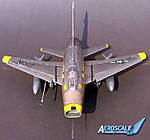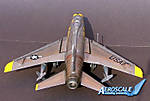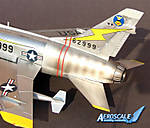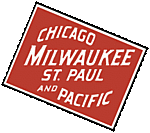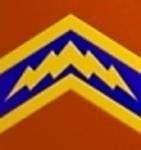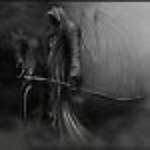1⁄35Century Series Fighters Pt. 1
11
Comments
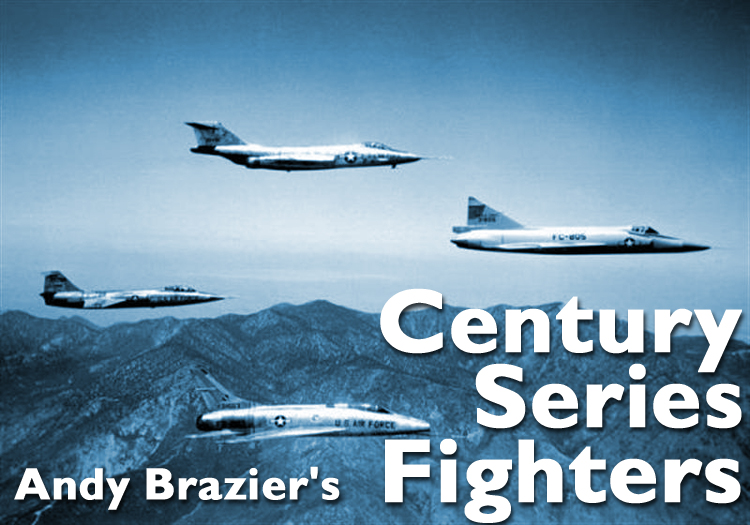
Century Series Part 1
The jet age is epitomized by the lengendary Century series of ighters.The Century series aircraft, were tasked with defending the American homeland from the Soviet forces at the height of the Cold War, fighting a tenacious enemy over Vietnam and were also the backbone of NATO's nuclear strike force.
They have been used as interceptors, bombers, reconaissance and in nearly every conceivable role in between.
F-100 Super Sabre
The North American F-100 Super Sabre was the first USAF aircraft to achieve supersonic speed in level flight and the replacment for the "TopDog" of the fighter world, the F-86 Sabre from the early fifties. Where the F-86 looked "pretty" the "Hun" as it became known, was good looking in an altogether sleeker, more business and shark-like manner.North American Aviation had already built the highly successful P-51 Mustang and F-86 Sabre and brought them the staus of Americas leading fighter company. It was hoped the F-100 would continue this trend with its first supersonic aircraft.
NAA's plans for a supersonic Sabre in Febuary 1949, was to give the F-86D a more swept back wing and a new engine. The USAF rejected this idea and asked for a new day fighter. NAA's response was simply known as NA-180 Sabre 45 (the 45 indicating the degree of the swept wing) and had the combined features of an advanced F-86D and E Sabre. It bore little resembelence to the F-86 except in basic configuration and structural design, and was significantly larger, faster and more powerful with different control and revised tail design layout.
The new Sabre was to be powered by the new Pratt and Whitney J57-P-1 turbojet. Rated at 15,000lb with afterburner, it would give the sabre a top speed of Mach 1.3 at 35,000ft.
The aircraft was originally perceived as a radar equipped interceptor, but that role was given to the new F-102 Delta Dagger and NAA was directed to make the Sabre 45 into a simple day fighter without radar and armed with 4x20mm cannons. This suited NAA down to the ground as, without the radar, the plane could use a large unobstructed nose intake to feed the new J57 engine.
In October 1951 the USAF Council pressed for the devolopment of the Sabre 45 proposal. NAA hoped the USAF would want 2 prototypes built, but the Air force Council wanted the Sabre in service much sooner then conventional procurement plans would allow, thus on 1 November 1951 they issued a Letter Contract for 2 prototypes and 110 production aircraft. Full production was to be initiated before flight testing was completed. One month later the Sabre 45 was given the new F-100 designation. The first flight of the Super Sabre was made by Company test pilot George S "Wheaties" Welch on the 25 May 1953 at Edwards AFB. On his first 55 minute flight the Sabre exceeded the speed of sound. The second protype shortly followed the first into the air, and 5 days later was shown to the press. George Welch flew the aircraft past the press grandstand just a few feet from the ground at Mach 1, creating a sonic boom which left broken windows at the adminstration building at Palmdale.
The F-100 was the subject of many modification programs over the course of its service. Many of these were improvements to electronics, structural strengthening, and projects to improve maintainability. One of the more interesting of these was the replacement of the original afterburner of the J-57 engine with the more advanced afterburners from retired Convair F-102 Delta Dagger interceptors. This modification changed the appearance of the aft end of the F-100, doing away with the original "petal-style" exhaust. The afterburner modification started in the 1970s and solved maintenance problems with the old type as well as operational problems, incl. compressor stall problems.
Although it never succeeded as a fighter, which cost the NAA its lead in fighter devolopment and was never to build another production fighter, the "Hun" found its true calling in the less glamourous world of fighter/bombers.
Variants
YF-100 - Prototype, later designated TF-100A; two built.F-100A - Single-seat day fighter; 203 built.
RF-100A (Slick Chick) - F-100A modified for photoreconnaissance, six modified in 1954 (53-1545,1546,1547,1548,55-1551,55-1554). Unarmed, with camera installations in lower fuselage bay. Retired from USAF service in 1958. Four transferred to Republic of China, retired in 1960. F-100B - North American YF-107
F-100BI - Proposed interceptor version of F-100B, did not advance beyond mockup.
F-100C - Additional fuel tanks in the wings, fighter-bomber capability, probe and drogue refueling capability, uprated J57-P-21 engine on late production aircraft. First flight March 1954; 476 built.
TF-100C - One F-100C converted into a two-seat training aircraft.
F-100D - Single-seat fighter-bomber, more advanced avionics, larger wing and tail fin, landing flaps. First flight 24 January 1956; 1,274 built.
F-100F - Two-seat training version, armament decreased from four to two cannon. First flight 7 march 1957, 339 built. DF-100F - This designation was given to some F-100Fs that were used as drone directors.
NF-100F - Three F-100Fs used for test purposes, the prefix N indicates that modifications prevented return to regular operational service.
TF-100F - Specific Danish designation given to 14 F-100Fs exported to Denmark in 1974, in order to distinguish these from the 10 F-100Fs delivered 1959-1961.
F-100J - Unbuilt all-weather export version for Japan.
F-100L - Unbuilt variant with a J57-P-55 engine.
F-100N - Unbuilt version with simplified avionics.
F-100S - Proposed French-built F-100F with Rolls Royce Spey Turbofan engine.
Performance
Maxium speed: 750 knots (864 mph, 1,390 km/h)Range: 1,733 nm (1,995 mi, 3,210 km)
Service ceiling: 50,000 ft (15,000 m)
Rateof climb: 22,400 ft/min (114 m/s)
Wing loading: 72.1 lb/ft² (352 kg/m²)
Thrust/weight: 0.55
Lift to drag ratio: 13.9
Armament
Guns: 4× 20 mm (0.787 in) M39 CannonMissiles: 4× AIM-9 Sidewinder or GAM 83 Bullpup
Bombs: 7,040 lb (3,190 kg) of weapons, including:
Conventional bombs or
Mark 7 Nuclear bomb or
MK 28 Nuclear bomb or
MK 43 Nuclear bomb or
MK 57 Nuclear bomb or
MK 61 Nuclear bomb
Model
1/48 Monogram F-100 Super Sabre. Built out of the box with the exception of adding Legend Productions 335 Gallon Drop Tank Set.Painted with different colour Alclad II paints. Tamiya and Xtracrylix acrylics used for the cockpit, wheel bays, nose and wing tip colours.
Markings are for 20th TFW, 79th TFS at Nouasseur AB, Morroco, June 1958.
Comments
Really nice idea.
I enjoyed reading it and the pics are great too.
Lovely job Andy. Fascinating.
Can't wait for part two.
Cheers
Peter
APR 14, 2007 - 02:50 PM
Hi Andy
I'm afraid my trusty spellchecker doesn't work with the latest version of Firefox - so it's mea culpa if anything slipped past my Mk. 1 eyeballs.
All the best
Rowan
APR 14, 2007 - 03:00 PM
Great little history lesson. A very nice feature.
The Alclad paint really works. You did a fantastic job on the bare metal finish.
Thanks for sharing - I am looking forward to the next part
APR 15, 2007 - 02:51 PM
Hi Andy!
Great Feature and great model!
Looking forward to number 101!
Jean-Luc
APR 15, 2007 - 10:21 PM
Thanks guys. I enjoyed writing it as I learnt a fair bit as well.
Part 2 is in the process of being written at the moment.
Andy
APR 16, 2007 - 12:15 AM
Andy,
I really liked the model depicting the 79th TFS F-100. You did a splendid job and interestingly, I am working on pretty much the same model. I have a uncle who served in the 79th in the 50's and actually flew a F-100D "FW-012" out of RAF Bentwaters! I would like to ask you how you got the yellow decals? or was that paint? I am using the same Monogram kit and am wondering if there is a good markings solution for my aircraft. Any help would be appreciated. If you would want to chat off line about this, you can email me at [email protected]
MAY 05, 2010 - 06:18 AM
Kim.
Andy has had major computer problems recently. I spoke to him on the phone this evening and he's hopefully going to back online next week and will contact you then.
All the best,
Nige
MAY 05, 2010 - 07:55 AM
Quick! Everyone! Hide!
No, seriously, it will be fantastic to have Andy back! He has been sorely missed.
All the best
Rowan
MAY 05, 2010 - 09:27 AM
Very interesting read thanks andy.And kudos on the model I might have to add one to the collection.Im going to have to build another house at the rate im going
Build On,
Justin
MAY 05, 2010 - 12:27 PM
Copyright ©2021 by Andy Brazier. Images also by copyright holder unless otherwise noted. The views and opinions expressed herein are solely the views and opinions of the authors and/or contributors to this Web site and do not necessarily represent the views and/or opinions of AeroScale, KitMaker Network, or Silver Star Enterrpises. Images also by copyright holder unless otherwise noted. Opinions expressed are those of the author(s) and not necessarily those of AeroScale. All rights reserved. Originally published on: 2007-04-15 00:00:00. Unique Reads: 17910





